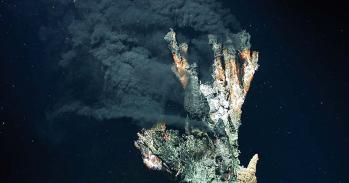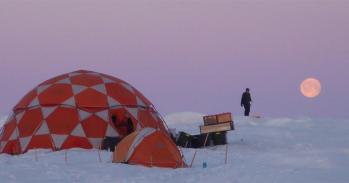
In the sixth in a series of reports contributed by Cambridge researchers, earth scientist Dr Marian Holness investigates the secrets locked into an ancient magma chamber that never erupted.
In the sixth in a series of reports contributed by Cambridge researchers, earth scientist Dr Marian Holness investigates the secrets locked into an ancient magma chamber that never erupted.
The campsite is carefully chosen to be as flat as possible, convenient for the sea and sheltered. A fine view is a bonus.
Dr Marian Holness
East Greenland is not a holiday destination. Sheer mountains rise out of the ice-covered sea. Plants are rare, land animals rarer. The window for fieldwork is short, between the melting of the old snow and the arrival of new in September.
We arrive at the mining base on a Twin Otter plane, landing on carefully rolled moraine. The miners are welcoming but the mood is tense: most of our kit is on a ship stuck in sea-ice outside the fjord. After three days the captain finds a way through and the helicopter pilots unload the ship. The tents go up, and we construct the trip-wires that will give us precious extra seconds if a polar bear visits. We decide on the protocol for the rifles: the bolt closed above the full magazine, no rounds in the chamber, trigger pulled, safety catch off.
It’s good to be back. Familiar people, familiar ways of working and the simplicity of existence reduced to staying warm, eating, and looking at rocks. We’re studying an ancient magma chamber. Large underground bodies of molten rock usually feed volcanic eruptions but ours is unusual because it never got emptied: instead it quietly solidified inwards from the edges. We’re interested in the mushy crystal layer that grew on the walls. The shrinkage that occurred as it solidified sucked in liquid that reacted with the mush. We’re working out the details of this reactive infiltration. It’s difficult to hammer off samples so we’ve brought a rock drill. Our post-doc has to carry it. He gets teased a lot but he’s stoic.
The campsite is carefully chosen to be as flat as possible, convenient for the sea and sheltered. A fine view is a bonus. We use Thermarest mattresses and high-performance down sleeping bags, with bundles of clothes for pillows. I never manage a good night's sleep: it doesn't get properly dark, you're listening out for intruders, you're often painfully tired, and the ground is hard!
We are all safety-conscious. The sea is frigid: we avoid falling out of the boat. We might get stranded so wherever we go we always take food and a tent. Food assumes overwhelming importance. It must be hot, stodgy and copious. I eat more than usual but still come home several kilos lighter. Most was shipped from the UK, but all the treats come from Iceland. Fieldwork in Greenland is immeasurably improved by the delights of black bread and pickled herring. Keeping clean is not so important (if no-one washes then nobody notices the smell). Merino underwear can be worn for weeks before becoming unacceptable. Washing, such as it is, takes place in a melt-water lake.
Leaving proves as stressful as arriving. The ship is stuck in sea-ice. When she finally arrives we are exuberant: showers, soft mattresses and haut cuisine (pickled herring features prominently). Our exuberance is short-lived. We are hit by a gale, prostrating us with sea-sickness. As we creep out of our bunks in ones and twos the chef designs increasingly ambitious menus, calibrated to the ambient level of queasiness. By the time the wind drops and we’re once again stuck in ice, we’re back to full Danish feasts.
It takes three more days to get through the ice to Mestersvig. This military settlement, with a dozen huts, three huskies and an airstrip, seems like a metropolis. Once there, everything happens quickly. A Twin Otter arrives and we’re off to Iceland and the certainties of commercial flights.
Back at home it takes time to re-adjust to normal life. You’ve been focused on staying alive and working effectively with few people in a very intense relationship. Now you need to deal with crowds and trivia. My family finds my insouciance irritating: we’re warm, dry, fed and there are no predators lurking in the garden – does it matter that we can’t find the car keys?
Dr Marian Holness
Marian is a Reader in the Department of Earth Sciences, and a Fellow of Trinity College. Her primary research interest concerns decoding the clues to a rock's history that are recorded in its microstructure. She is currently trying to work out the behaviour of the complex crystal mushy layers that develop during the solidification of silicate magma, both in large magma chambers and in smaller intrusions such as lava lakes. Marian's fieldwork in Greenland was supported by the NERC and the Carlsberg Foundation.
This work is licensed under a Creative Commons Licence. If you use this content on your site please link back to this page.





